One month in Kabul: Week one
The first week of Hamish Macdonald’s One month in Kabul blog.
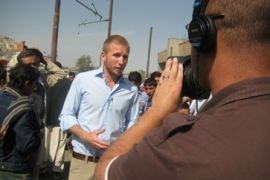
Al Jazeera’s Hamish Macdonald is in Afghanistan during a critical period: The United States is shifting its focus from Iraq to Afghanistan, thousands more troops are being sent, and national elections are due within months.
Afghanistan is one of the biggest news stories in the world at the moment, but for ordinary Afghans life goes on as usual. People are shopping, going to school and trying to build their lives.
He is keeping a log of life in the war-torn nation, the hopes and aspirations of its people, and the stories they tell.
The following are his entries from week one.
| February 15, 2009: In Pul-i-Khumri |
Afghanistan’s Little Moscow:
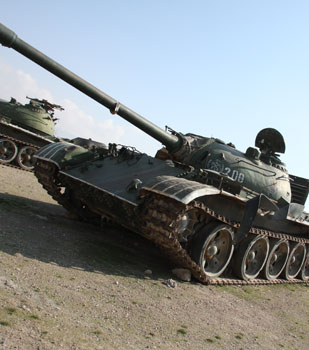 |
| Tanks left behind in Pul-i-Khumri by the Soviet troop withdrawal in 1989 [HAMISH MACDONALD] |
“The name’s Tank, Karim Tank.”
I can’t understand Dari, but that’s kind of how I imagined the man we just interviewed would probably introduce himself.
He’s a former Mujahideen fighter turned Afghan police officer who is passionate about – you guessed it – tanks.
We have been travelling around the town of Pul-i-Khumri in Afghanistan’s Baghlan Province looking for people who remember the days when this place was actually known as Moscow Kochak – Little Moscow.
And Karim Tank is apparently one of the experts. He didn’t live here at the time, but he spent plenty of time driving through the surrounding hills in tanks trying to end the Soviet occupation.
He’s still got that cowboy streak. When we ask him to drive his police truck along the river to help us get some pictures for our TV story about Pul-i-Khumri he runs off quickly, turns the sirens on and screams down the dirt track ready for our camera-man to shout action!
You get the feeling he’s a guy who likes adrenalin.
During the Soviet occupation, which ended on this day 20 years ago, there would have been plenty of action around here. Pul-i-Khumri was home to one of the biggest Soviet military bases in the country.
Today it looks like most of the other towns we have driven through in the north of the country, apart from the enormous yellow bread factory that stands towering over the river as a monument to the days when employment and production lines were a big part of winning ‘heart and minds’.
There are still a few other reminders of that period dotted around Pul-i-Khumri. There are tank graveyards lining the road between hear and Kabul, while the scrap metal poached from the ageing tanks can be found in some unusual places.
On the Salang river, children charge people a few Afghani (the local currency) to cross the water on rafts made out of Soviet scrap metal. I was wondering as we made the short journey whether one day people in Afghanistan might cross rivers on boats made from the scraps of US or British tanks.
It is perhaps worth noting on this 20th anniversary of the Soviet withdrawal from Afghanistan that many of the military leaders who formulated Moscow’s failed strategy during that period now believe the US is making many of the same mistakes.
Perhaps that helps explain why Washington seems so eager to involve Moscow in finding a new strategy for dealing with this conflict.
They only need to look at the rusting tanks in Pul-i-Khumri to remind themselves of the dangers of getting it wrong.
To see Karim Tank in action, click here.
| February 13, 2009: In Kabul |
Well, really?
 |
| At least 20 people were killed in Taliban attacks on government buildings in Kabul [GETTY] |
It was one of those excruciating moments that only happen when you are watching television.
You know the person being interviewed is being a bit liberal with the truth but you can’t do anything to actually prove them wrong.
When Al Jazeera’s David Foster was interviewing brigadier general Richard Blanchette, the spokesman for the International Security Assistance Force (ISAF) on during the Newshour from Doha on Wednesday I actually wanted to run upstairs to the roof of our office where the live interview was being conducted to spin the camera around and reveal the truth.
The interview was focusing on security in Kabul following Wednesday’s suicide attack on three government buildings, which killed more than two dozen people. The Taliban claimed responsibility.
Blanchette began his assessment of the situation in the capital by saying: “As I’m standing here and I look down at the street full of cars, Kabul is still a thriving city … there’s no doubt in my mind, the construction that you see around, the level of activity is certainly showing that the people of Afghanistan and the Kabulese certainly want to have progress and these savage attacks yesterday are not going to have that much of an impact on the people of Afghanistan because they have said very loudly that they want this to stop.”
Foster thoroughly challenged the ISAF spokesman on those claims, because clearly the situation is Kabul is not good.
The war-weary people of this city are feeling intimidated as a result of these attacks and security measures seem to be intensifying on a daily basis.
Many of the public thoroughfares around the government precincts have been closed off completely to drivers, making this city’s traffic nightmare even worse.
But what made this interview ultimately frustrating to watch was that while the brigadier general was claiming the capital is calm and secure, he was actually surrounded by armed security guards.
Unfortunately, you couldn’t see this on camera. An advance party was dispatched to our office before the spokesman arrived, presumably to ensure the location was safe. When the Brigadier General eventually arrived, he was accompanied by further security personnel, who focused on maintaining a secure environment while the interview took place.
Clearly the brigadier general is well within his rights to come for an interview accompanied by a security attachment, in fact he is probably sensible to do so.
Foreign military leaders face a different security threat compared with the security issues faced by Kabul’s residents.
But it seems to me to be slightly contradictory to then appear on international television talking about how safe the city is.
If the capital of Afghanistan is so secure, why do you need big guys with guns?
In the end, this is about message and spin.
The message being sent to the world about the situation in Afghanistan is often very different to the reality on the ground.
Richard Holbrooke, the new US special envoy to Afghanistan, is here at the moment listening to military and political leaders about their perceptions of the situation.
Maybe he will demand the message without all the spin?
| February 12, 2009: Passing through Kunduz province |
On the road to Tajikistan:
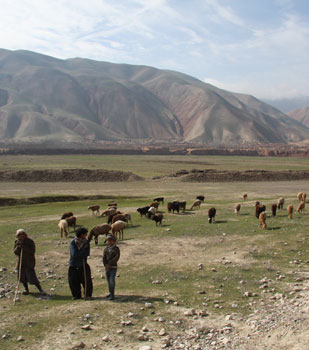 |
| Shepherds in Kunduz province [HAMISH MACDONALD] |
We have just returned from one of the most beautiful places I have ever seen.
But it was a horrendous trip getting there, with two flat tyres in two days, hassles from border police and a nasty snowstorm, which added hours onto our journey.
Glimpsing a view of Northern Afghanistan’s dramatic landscape, however, was well worth the effort.
We spent the past few days travelling along what will soon become the new supply route for US and Nato forces in Afghanistan.
They are in desperate need of safe passage for their military supplies because the route they use currently, which passes up the Jalalabad highway from Pakistan, has become far too dangerous as a result of frequent Taliban attacks.
The northern end of the country is the next best option, but you only need to look at the distance on the map and take a drive across the treacherous Salang Mountain pass to see that this isn’t exactly going to be easy.
The mountains are covered in snow year round and the two-lane highway is frequently closed during winter because of heavy snowfall; we spent a good few hours in either direction waiting to get through.
The trucks laden with heavy cargo can barely make it up the hill, let alone do so in icy conditions.
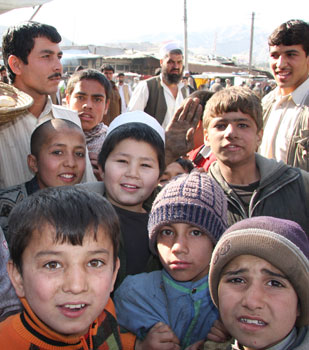 |
| Children Al Jazeera met on the way to Tajikistan [HAMISH MACDONALD] |
This is not the kind of road you would want to be reliant upon for supplying your weekly shopping, let alone a war effort.
The road doesn’t get much better in the low-lying valleys, either.
Here on the longer stretches, vehicles reach terrifying speeds and drivers barely flinch even when they come within metres of a head-on collision. It makes Formula 1 racing seem like the safe option!
At least these changes are making the long-suffering truck drivers happy – they ride rickety old Russian-built Kamaz trucks and they reckon that business is about to start booming for them.
They also seem to think local communities along the highway will benefit from the increased traffic.
It is an incredible sight seeing Afghan farmers ploughing the fields in their traditional dress, while convoys of trucks scream past, narrowly missing flocks of sheep. The sheep may not stand much of a chance when this road gets busier.
I’m posting some pictures from our journey with this dispatch, including shots of some of the people we met along the way.
| February 11, 2009: In Kabul |
City under assault:
 |
| A policeman carries a broken gun belonging to one of the men behind the February 11 Kabul attacks [AFP] |
It is hard to describe what it feels like being in a city where suicide bombers strike with almost habitual frequency.
Barely a week goes by in Kabul without a suicide attack of some description.
The people here have unfortunately learnt to live with these kinds of attacks. And in that context, it takes a lot to shock the people of Kabul.
But today’s violent attacks on government buildings in the heart of the city have broken through that barrier and shocked the Kabul community.
My Afghan colleagues in the bureau here are always good barometers of public sentiment – and judging by the number of phone calls they’ve been receiving today from worried friends and relatives, these attacks have actually managed to frighten the war-weary people of this country.
Driving through the north of the city tonight, it was evident that Kabul is effectively in lock-down. There are always security checkpoints at night in Kabul, but I’ve never witnessed anything quite like this. We passed at least half a dozen police checks, but come Thursday morning there will no doubt be more.
It is comforting of course for the foreigners working here to see security out in force. But just imagine how much of an inconvenience this will be for ordinary people as they try to get to work, do the shopping and take the children to school.
We’ll be covering the aftermath of these attacks on Al Jazeera over the coming days – and the impact on people’s lives.
And an additional note: we’ve just returned from our trip to the north of Afghanistan. We made it to the border with Tajikistan, so we’ll have some interesting stories and great pictures (as promised) in the coming days.
| February 10, 2009: Along the Salang Pass |
Breakdown in Afghanistan:
 |
| Snow made travel along many routes in northern Afghanistan difficult [GETTY] |
I reckon the last place in the world you would want to be when you have a flat tyre in your 4×4, in the dark, in the middle of a blizzard is Afghanistan. Agreed?
Well, that is exactly what happened to us last night as we travelled up the highway from Kabul, through the Salang Pass, to the country’s north.
The snow was falling heavily and some friendly locals were trying desperately to help us mend the sizable puncture which had appeared in our rear tyre while we attempted to fit snow chains.
It was almost impossible to see out of the front window – I hate to imagine what it must be like for the thousands of truck drivers travelling along this route every day carrying hundreds of kilogrammes worth of goods in their cargo!
We are travelling along what will soon become the US and Nato’s brand new military supply route. They have managed to negotiate a deal with Moscow which would allow supplies to come through Russian territory.
Basically, the US and Nato have had such problems with their current supply route, which comes along the Jalalabad highway from Pakistan, that they have had to find an alternative.
For sure, this new supply route is less prone to suicide bombings and roadside IED’s (improvised explosive devices), and there have been very few incidents of violence in the north of the country.
But the dangers may come from elsewhere. These roads are not in good condition, they are treacherous at night and probably not well-equipped to cope with the added burden of countless more trucks passing through with military supplies.
The people who live in this region seem pretty fearful as well. They take pride in the fact that theirs is one of the safest parts of Afghanistan, but there is justified concern here that once the Americans and their Nato allies begin trucking tonnes and tonnes of equipment and supplies down these roads, this region too will become a target for attacks by the Taliban and al-Qaeda fighters.
The local police have already asked for reinforcements.
This has so far been a spectacular road trip, but the highway from Kabul through the Salang Pass toward Turkmenistan doesn’t seem to be the fail-safe alternative the Western forces seem to think it is.
We’ve got our tyre fixed now and are about to continue on our journey.
Will keep you posted on our journey through one of the most beautiful parts of Afghanistan. Photos to come in the next few days.
| February 7, 2009: Somewhere outside Kabul |
iPhones and the Taliban:
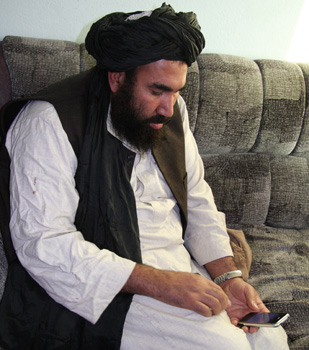 |
| Mullah Zaif, the former Taliban ambassador to Pakistan, says he is ‘addicted’ to his iPhone |
I could not believe my eyes. We had arrived to interview Mullah Zaif, the Taliban’s former ambassador to Pakistan who is now under virtual house-arrest on the outskirts of Kabul, when he walked into the room, sat down on the couch and pulled out an iPhone.
A former member of the Taliban! An iPhone! How times have changed.
During Taliban rule, which ended when the US and its allies rolled in and took control of Kabul in 2001, the leadership had banned just about anything associated with modern technology.
There were no televisions, no computers, no radios, no music and though iPhones were not around back then, they most certainly would not have been allowed.
I asked Zaif about his gadget. His response was pretty much the same as everyone who owns an iPhone.
“I’m addicted,” he said, “the internet is great on this, very fast.”
He proceeded to show myself and our film crew his favourite websites. I half expected him to log on and show us ‘Taliban Twitter’.
But there is a very serious side to all of this of course.
The Taliban and other groups opposed to US military operations in Afghanistan and Iraq have been incredibly quick to latch on to new technology and methods of communication.
It has enabled them to wage their war in a sophisticated fashion, using not just guns and bombs, but messages and propaganda too.
When reporting from Afghanistan I am always amazed at how quickly we get information from all sides of the conflict with vastly different accounts of what happened.
It is fair to say that no single version is the truth, and that is why we always try to report what every side is saying.